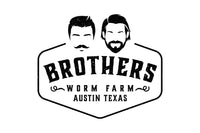
How Many Composting Worms Do I Need?
If you are starting a worm compost bin for the first time, one of the first questions you probably have is “how many worms do I need”.
In fact, the question of how many composting worms you need for worm farms, gardens, and raised beds is one of the most common inquiries we get from customers!
In this guide we'll provide all of the details you need, including:
- how many worms you should start with based on the size of your worm bin
- how many worms you need for a garden or raised bed based on its size
- how much food red wigglers will consume
- loads of FAQs on how wigglers eat, breed, and handle density in their bin
How Many Worms Do I Need for a Worm Composting Bin?
The number of worms needed for a worm composting bin depends on the square footage of the bin and how much waste you want to compost each week. 1 pound (~1,000) of compost worms per square foot of worm bin space is a good benchmark, and some experienced worm composters will go as high as 2 pounds per square foot. However, if you are new to worm composting, we recommend starting with ½ to 1 lb of worms per square foot, and then increasing the population over time as you gain experience.
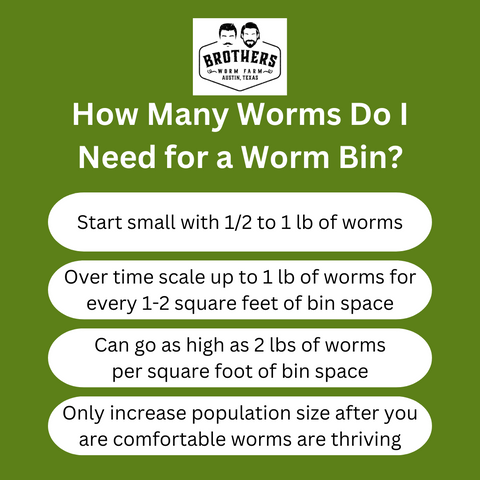
Worms will process ¼ to ½ their weight every 3-4 days, so it’s important to calculate how much food to place in the worm composting bin each feeding based on the size of your worm population.
How Many Red Wigglers Should I Start With?
If you are just getting started with a worm compost bin, we recommend starting with a small bin like an indoor worm compost bin or even a 5 gallon bucket and ½ to 1 pound of red wigglers. Use the first 4-6 weeks to verify the worms like the bedding, environment, and food you are serving, and then expand your worm population up to ½ to 1 pound of red wigglers per square foot.
It’s important to remember that most species of compost worms (e.g., red wigglers) live and breed in the top 2-3 inches of soil, so surface area is a more important factor in determining population size than depth of the worm bin!
Over the long-term, the general rule of worm composting is to use one pound of red wigglers for every square foot of surface area of your bin.
For a standard bin measuring 2 feet x 2 feet, this rule equates to about 4 pounds of red wigglers (as info there are approximately 1,000 red wigglers per pound).
Under normal conditions (e.g., ambient temperatures in the 50-80 degree F range and food that is easy for the worms to consume), red wigglers will eat their weight in waste every week.
So, for example, 4 pounds of red wigglers will consume around 4 lbs of food per week.
Note that you don't have to have 1 lb of worms per square foot of bin space, but this amount is a safe density for the worms and will maximize the amount of waste that can be processed in your bin.
How Many Worms Can Live in a 5 Gallon Bucket?
A 5 gallon bucket can comfortably support 1 pound of red wiggler worms, which is equivalent to roughly 1,000 worms. It’s important to remember that red wigglers live in the top 2-3 inches of soil, so surface area is more important than depth in determining how many worms can live in a 5 gallon bucket. Certain species of worms like nightcrawlers burrow 12-16 inches into soil, so 2 pounds of nightcrawlers can live in a 5 gallon bucket since they will use more of the vertical depth of the bucket.
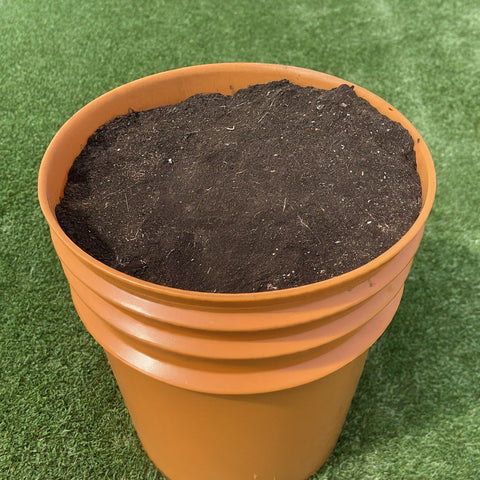
How Many Worms per Gallon of Soil
For 1 gallon of soil in a small bin, we recommend around 100 worms. Since a gallon of soil is a small amount, a density of 100 worms allows the worms enough space to feed and reproduce without overcrowding. A better measure for how many worms you need, though, is the square footage of the bin or container the worms are in - if the container is 1 foot by 1 foot and has bedding to a depth of 3-4 inches, then you can fit around 1,000 worms (1 pound) in the container.
How Many Red Wigglers per Square Foot
For most worm compost bins it is good to aim for around 1 pound (or approximately 1,000 red wigglers) per square foot of bin space. This density is ideal for maintaining robust composting without having the worms compete too much for food. However, if you are new to worm composting, start with ½ pound of red wigglers until you get the hang of caring for the worms.
Once you are comfortable the worms are healthy and happy, you can increase density as high as 2 pounds of red wigglers per square foot of bin space.

Increase worm density above 1 lb per square foot only after you're confident the worms are thriving!
How Many Red Wigglers per Cubic Foot
For each cubic foot of your worm compost bin, you can house up to 1,000 red wigglers. This quantity of worms is effective for breaking down organic matter, and the density will ensure the worms are not over-competing for food and continue breeding.
How Many Worms Do I Need for a Garden
Adding worms to a garden is different from adding them to a worm compost bin where processing waste is the main goal, so you generally need fewer worms per square foot in a garden. For gardens, aim to mimic nature where there may only be 1-15 worms per square foot of land. Smaller gardens of 50 square feet can start with ½ pound of worms (~500 worms) while larger gardens can start with 1 pound of worms (~1,000 worms) for every 100 square feet.
How Many Worms Per Square Foot of Garden?
When adding worms to a garden it’s important to verify 1) the worms can thrive in the soil, 2) there is adequate shade and food supply, and 3) the soil remains moist for the worms. If these elements are in place, aim for 1-15 worms per square foot of garden space. A 200 square foot garden can start with 2 pounds of worms (~2000 worms).
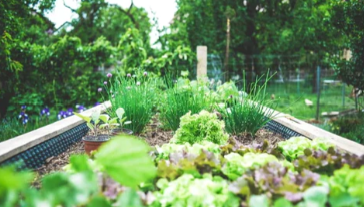
Mimic nature and aim for 1-15 worms per square foot of garden space.
Over time, the worms in the garden will manage their population, breeding when conditions are good and slowing down their breeding if density, food, or temperature become a problem.
How Many Worms Do I Need for a Raised Garden Bed?
Raised garden beds follow the same worm density guidelines as a garden - mimic nature and add 1-15 worms per square foot of raised garden space. A raised garden bed that is 3 feet by 3 feet (9 square feet) should start with 100-150 worms. The worms will breed and the population size should increase if soil, moisture, and temperature conditions are good for their survival.

How Many Worms for a Compost Pile?
Since the goal of adding worms to a compost pile is for the worms to process as much compost as possible, consider a worm density of ½ to 1 lb per square foot of compost surface area. However, we recommend starting with a smaller amount to verify the worms thrive in the pile. If your compost pile is 4 feet by 4 feet with 16 total square feet, start with 2-4 pounds of worms and work up to 8-16 pounds over time. The worms will do some of this work for you as they should breed and increase population on their own.

Frequently Asked Questions: How Many Composting Worms Do I Need?
How much space do 1000 red wigglers need?
As a general rule aim for ½ to 1 pound of red wigglers per square foot of bin space you have available. So 1000 red wigglers need a minimum of 1 square foot of space. This amount of space provides just enough room for the worms to thrive and process organic materials effectively, but the worms may not breed as much due to competition for space and food.
Can I start a worm farm with 500 worms?
500 worms is a good number of worms to start a worm farm. There are 2 reasons for this - 1) Most indoor worm farms are smaller, with 3-4 square feet of surface area, so 500 worms will fit comfortably in this area and leave them room to grow their population, and 2) if you are just starting out with a worm farm, we recommend starting small with 500 worms to vet that the worms thrive in your worm farm set-up.
Once your worm composting process is up and running and you are comfortable the worms like the bedding, moisture levels, and feedstock, you can add more worms up to 1 pound of worms (1,000) per square foot of bin space.
Can you have too many worms in your worm farm?
Yes, overcrowding can stress worms and reduce their productivity as well as their breeding. The reason for this is that too many worms in a small space increases competition for space and food, which can impact worm health and the overall performance of your worm farm. A good rule of thumb is to aim for 1,000 (1 pound) worms per square foot of space in your worm farm.

Too many worms in a small space can cause stress, causing worms to die or leave the bin.
How many worms are in 1 lb of red wigglers?
There are approximately 1,000 red wigglers in 1 lb. The actual worm count can vary based on the size of the worms in a given population, so the range of red wigglers in 1 lb is usually 800 - 1,100 worms. The amount in 1 lb is different for other species like European nightcrawlers, which are larger worms and generally have 275 - 350 worms per pound.
How fast do red wigglers reproduce?
Red wiggler reproduction rates vary based on a number of factors, including temperature, time of the year, feedstock, and density of worms in the worm bin. Under perfect conditions, usually in the spring when conditions are optimal, red wigglers will double their population size every 2-3 months. Under average conditions it is better to assume red wigglers will double their population size every 5-6 months.

Red Wigglers are prolific breeders!
For more on the amazing red wiggler reproduction process, check out our "How Do Worms Reproduce" guide.
Do worms multiply in a compost bin?
Yes, worms will reproduce naturally in a compost bin if conditions are favorable. The most important factors in worm breeding are: 1) available feedstock that is easy for the worms to consume, 2) moist conditions 3) density of ⅛ to ¼ pound of worms per square foot of bin space and 4) ambient temperatures in the 60-80 degree F range. If the conditions in the bin meet these criteria, you can expect worms to double their population size every 4-6 months.
Can you overfeed a worm bin?
Yes - overfeeding a worm bin is a common issue that can lead to many problems including odor, pest infestations, and even death or sickness in your worm population. These issues are the result of worms not being able to process food quickly enough, which can lead to uneaten food decaying and creating anaerobic or other harmful conditions in the worm bin. Worms can eat ¼ to ½ their weight in food every 2-4 days, so it’s important to stick to this rule to avoid problems in your bin.

Overfeeding a worm bin can lead to many avoidable problems
For more on feeding compost worms and red wigglers, see our comprehensive compost worm feeding guide on what to feed worms and what foods to avoid.
How many pounds is 500 red wigglers?
There are roughly 1,000 red wigglers per pound, so 500 red wigglers is ½ lb of worms. For larger species like European nightcrawlers, there are around 300 worms per pound or 150 worms per half pound.
Can you just put red wigglers in your garden?
Yes, red wigglers can be put directly in your garden. Worms will perform the same essential roles in your garden that they do in nature. Numerous academic studies have shown that having red wigglers in soil significantly enhances soil health and contributes to plant growth, with benefits ranging from higher crop yield to larger plant biomass as well as the suppression of pests and diseases.
Can I mix nightcrawlers and red wigglers?
Yes, it is perfectly acceptable to mix red wigglers and nightcrawlers, and they will live harmoniously in the same worm bin, garden, or compost pile. The 2 species will not breed with one another, but both worm types live and thrive in similar conditions so it is perfectly acceptable to mix the 2 worm types in the same space.
How often do red wigglers have babies?
Red wigglers, European nightcrawlers, and other worm species reproduce very quickly. Red wigglers can produce 1 cocoon per week, and it takes 3-4 weeks for the cocoons to hatch. Each cocoon can have 1-20 babies, but they average 2-4 baby worms per cocoon. So the entire reproduction process from mating to babies hatching form cocoons takes 4-5 weeks on average.
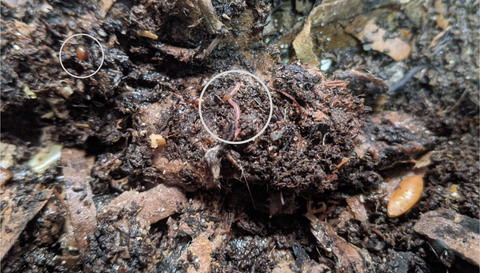
Baby red wigglers hatch and are an inch long within a few weeks time.
How do you keep red wigglers happy?
Red wigglers can survive in broad range of conditions, but to ensure the red wigglers stay happy and healthy it is critical that they have 1) moist bedding, 2) ambient temperatures in the 60-80 degree F range, 3) soft, easily-consumed food, and 4) natural bedding free of chemicals.
Most issues with worm bins occur with over-feeding which leads to adverse conditions in the bin, or ambient temperatures where the conditions in the bin get too hot (above 90 degrees F) or cold (below 40 degrees F).
How many worms does it take to start a Worm Factory?
500 to 1,000 worms is a good number of worms to start a Worm Factory, especially if you are just starting a worm compost bin for the first time. We recommend starting the worms in 1 tray of the Worm Factory. After successfully caring for the worms for a few months, you can scale up to 1,000 worms (1 lb) per square foot of space, and even have worms in multiple trays of the Worm Factory.
How many worms do I need to start a small worm farm?
When starting a small worm farm, start small with 500-1,000 worms in your worm compost bin. After caring for the worms and verifying they like the bedding, feedstock and other conditions in the bin, consider adding worms up to 1-2 pounds of worms (1,000-2,000) per square foot of bin space. For most in-home worm compost bins, target around 1,000 worms per tray or level in your bin.
How often do red wigglers eat?
Red wigglers eat constantly and will eat around ⅛ of their weight per day in food. For example, 1 pound of worms will eat 2-3 ounces of food per day, consuming their own weight in food every 5-7 days. When feeding red wigglers, it’s important to feed them soft, decaying foods that are breaking down so the food is easily consumed by the red wigglers.
Red wigglers don’t have mouths and teeth, so they actually feed on the microorganisms that are breaking down decaying food.
This means red wigglers will process soft, smaller foods faster than harder, larger pieces of food that aren’t yet decaying.
If possible, compost, cut-up, or even blend food before feeding your worms, and they will process more waste at a faster clip than if the food is in larger chunks.
